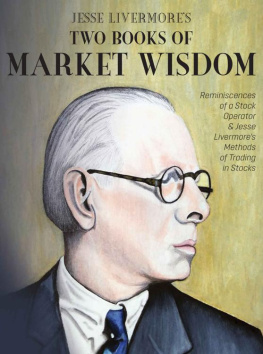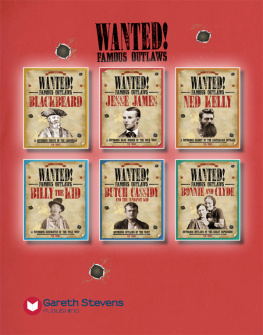Jesse Lauriston Livermore - Jesse Livermores Two Books of Market Wisdom
Here you can read online Jesse Lauriston Livermore - Jesse Livermores Two Books of Market Wisdom full text of the book (entire story) in english for free. Download pdf and epub, get meaning, cover and reviews about this ebook. year: 2019, publisher: Mockingbird Press LLC, genre: Detective and thriller. Description of the work, (preface) as well as reviews are available. Best literature library LitArk.com created for fans of good reading and offers a wide selection of genres:
Romance novel
Science fiction
Adventure
Detective
Science
History
Home and family
Prose
Art
Politics
Computer
Non-fiction
Religion
Business
Children
Humor
Choose a favorite category and find really read worthwhile books. Enjoy immersion in the world of imagination, feel the emotions of the characters or learn something new for yourself, make an fascinating discovery.
- Book:Jesse Livermores Two Books of Market Wisdom
- Author:
- Publisher:Mockingbird Press LLC
- Genre:
- Year:2019
- Rating:4 / 5
- Favourites:Add to favourites
- Your mark:
- 80
- 1
- 2
- 3
- 4
- 5
Jesse Livermores Two Books of Market Wisdom: summary, description and annotation
We offer to read an annotation, description, summary or preface (depends on what the author of the book "Jesse Livermores Two Books of Market Wisdom" wrote himself). If you haven't found the necessary information about the book — write in the comments, we will try to find it.
Jesse Livermores Two Books of Market Wisdom — read online for free the complete book (whole text) full work
Below is the text of the book, divided by pages. System saving the place of the last page read, allows you to conveniently read the book "Jesse Livermores Two Books of Market Wisdom" online for free, without having to search again every time where you left off. Put a bookmark, and you can go to the page where you finished reading at any time.
Font size:
Interval:
Bookmark:
Jesse Livermores Two Books of Market Wisdom
Reminiscences of a Stock Operator
By
Edwin Lefvre
&
Jesse Livermore's Methods of Trading in Stocks
By
Richard Wyckoff & Jesse Livermore
Edited by Juliette Rogers

Mockingbird
Press
Copyright 2019 Mockingbird Press
All rights reserved. The original works are in the public domain to the best of publishers knowledge. The publisher makes no claim to the original writings. However, the compilation, construction, cover design, trademarks, derivations, foreword, descriptions, added work, etc., of this edition are copyrighted and may not be reproduced, distributed, or transmitted in any form or by any including photocopying, recording, or other electronic or mechanical methods, without the prior written permission of the publisher, except in the case of brief quotations embodied in critical reviews and certain other non-commercial uses permitted by copyright law, or where content is specifically notes as being reproduced under a Creative Common license.
Cover, Livermore, Copyright 2019 Mockingbird Press
Foreword, Copyright 2019 Mockingbird Press
About the Authors attributable to Wikipedia, 2019 under CC BY-SA 3.0
Publishers Cataloging-In-Publication Data
Livermore, Jesse, author; with Lefvre, Edwin, author, and Wyckoff, Richard,
author, and Rogers, Juliette, editor
Title : Subtitle / Jesse Livermore; with Edwin Lefvre, Richard Wyckoff, and
Juliette Rogers
Paperback I SBN-13: 978-1-946774-56-9 ISBN-10: 1-946774-56-1
Hardback I SBN-13: 978-1-946774-57-6 ISBN-10: 1-946774-57-X
Ebook ISBN-13: 978-1-946774-58-3 ISBN-10: 1-946774-58-8
Library of Congress Control Number: 2019943407
1. Business & EconomicsPersonal FinanceInvesting. 2. Business &
EconomicsInvestments & SecuritiesStocks, 3. Biography & AutobiographyBusiness, 4. Biography & AutobiographyPersonal Memoirs, 5. RegionNew York City, 6. Economics, Finance, Business & ManagementFinance &
AccountingFinanceInvestment & Securities, 7. Biography, Literature &
Literary StudiesBiography & Non-fiction ProseMemoirs, 8. Economics,
Finance, Business & ManagementEconomicsEconomic History, I. Jesse
Livermore. II. Edwin Lefvre. III. Richard Wyckoff. IV. Juliette Rogers. V. Title. VI. Title : Subtitle
BUS050020 / BUS036060 / BIO003000 / BIO026000/ 4.0.1.2.2.4.0 / KFFM / DNC / KCZ
Type Set in Century Schoolbook / Franklin Gothic Demi / Franklin Gothic Book
Mockingbird Press, Augusta, GA
Foreword vii
Reminiscences of a Stock Operator
Chapter 1
Chapter 2
Chapter 3
Chapter 4
Chapter 5
Chapter 6
Chapter 7
Chapter 8
Chapter 9
Chapter 10
Chapter 11
Chapter 12
Chapter 13
Chapter 14
Chapter 15
Chapter 16
Chapter 17
Chapter 18
Chapter 19
Chapter 20
Chapter 21
Chapter 22
Chapter 23
Chapter 24
About the author
Jesse Livermores Methods Of Trading In Stocks
Chapter 1
Chapter 2
Chapter 3
Chapter 4
Chapter 5
Chapter 6
Chapter 7
Chapter 8
Chapter 9
About the Authors
In October 1907, panic gripped New Yorks financial institutions. Knickerbocker Trust Companythe citys third-largest trust collapsed, triggering a massive run on the banks. At the New York Stock Exchange, prices fell by almost half. The preeminent banker J.P. Morgan scrambled to organize a relief effort and restore public confidence.
Jesse Lauriston Livermore, a 30-year-old speculator known to Wall Street cronies as the Boy Plunger, had seen the panic coming and was poised to profit from it. For weeks, Livermore had been observing what he considered obvious warning signs from the market and taking up short positions as a result. Now, his insight was paying off. As others panicked, he profited. At the closing bell of October 24, 1907, Livermores gains tallied well over a million dollars.
As with many details of Livermores life, what happened next is not entirely clear. No doubt he stood to earn many more millions as the carnage consumed Wall Street. He might have realized, or been persuaded by others, that nobody would benefit from a destroyed financial system. Legend holds that J.P. Morgan himself messaged the Boy Plunger, begging for mercy on patriotic grounds. Whatever the reason, the following day Livermore reversed his bearish position, snapping up tens of thousands of shares at rock-bottom prices. Morgans relief plan had the opportunity it needed, and the crisis eased.
Years later, Livermore would remember October 24, 1907, as his day of days. In fact, his enigmatic life had more than its share of watershed moments, including successes exceeding that of 1907, and spectacular failures that pushed him to deep despair. Livermore lived aboard a roller coaster of his own making, but unlike most such thrill seekers, he dedicated himself to understanding the root cause of those highs and lows.
Born in rural Massachusetts in 1877, Jesse Livermore seemed destined for a life of farm labor, but his mother had other plans. At age 14, Jesse left the family farm for Boston, carrying a small bankroll to get him started. His first job was as a quote boy at Paine Webber, writing prices on the big board as they came across the ticker.
The stock ticker telegraph, an invention barely older than young Jesse, proved a boon to brokerages such as Paine Webberpermitting customers to buy and sell shares in nearly real time. But, like any major innovation, the ticker also spawned a dubious side. Bucket shops were nothing more than betting parlors, where patrons could wager on price movements without any actual securities changing hands. (Many amateurs failed to grasp this point, and unscrupulous bucketeers made no attempt to inform them.) Bucket shops thrived in every major city as ordinary people tried to cash in on the burgeoning U.S. economy.
At Paine Webber, Jesse did more than just scrawl the stock prices called out to him. He paid attention to patternsgoing so far as to keep a notebook of his observations. When another quote boy suggested they pool their resources and place a five-dollar bet at the local bucket shop, Jesse was intrigued. It paid off and his share of the winnings came to $3.12, which was all the encouragement he needed. He became a bucket shop regular, first during lunch breaks and then as a full-time speculator.
An uncanny sense of timing enabled Livermore to plunge deep into a stock and then get out quickly, earning handsome profits on the smallest price fluctuations. He did so well that the Boston bucketeers refused his business, forcing Livermore to travel New England skinning the skinners, as he liked to put it. When no shops remained that would permit him entry, he went to Wall Streeteager to storm the world of legitimate trading where he was promptly cleaned out.
After a retreat to St. Louis to reflect on his errors and refill his coffers, Livermore was back in New York. He studied the market and the ways of professionals, who succeeded with long-term strategy rather than rapid-fire tactics. Yet he still trusted his gut feelings over conventional wisdom and the advice of others. In 1906, Livermore inexplicably shorted Union Pacific Railroad mere hours before the San Francisco earthquake. As news of the devastation trickled east, he added to his positionbeating those who were slow to understand the consequences and ultimately walked away with a quarter of a million dollars.
Sometimes his instincts betrayed him, such as when a bold cotton play erased his glorious gains from the 1906 earthquake and 1907 market crisis. Livermore, as always, autopsied his faulty reasoning and then set to work building a new fortune. There would be plenty of drama along the wayincluding bankruptcies and divorcesbut his past defeats usually paved the way for future victories, such as his near corner on the cotton market in 1919.
Font size:
Interval:
Bookmark:
Similar books «Jesse Livermores Two Books of Market Wisdom»
Look at similar books to Jesse Livermores Two Books of Market Wisdom. We have selected literature similar in name and meaning in the hope of providing readers with more options to find new, interesting, not yet read works.
Discussion, reviews of the book Jesse Livermores Two Books of Market Wisdom and just readers' own opinions. Leave your comments, write what you think about the work, its meaning or the main characters. Specify what exactly you liked and what you didn't like, and why you think so.









